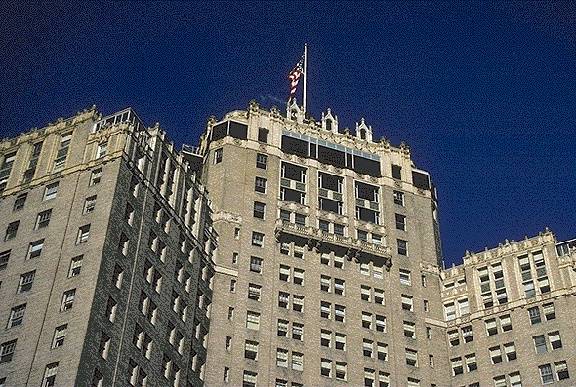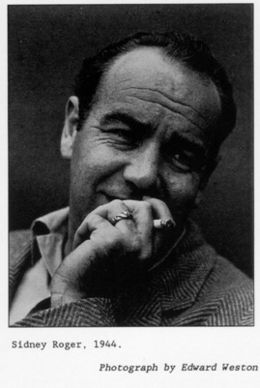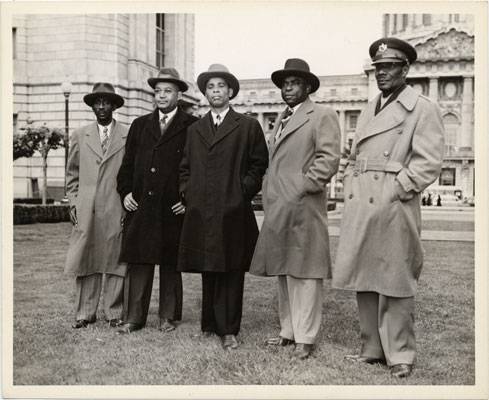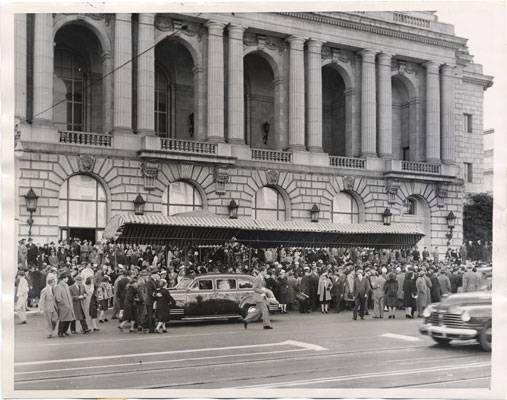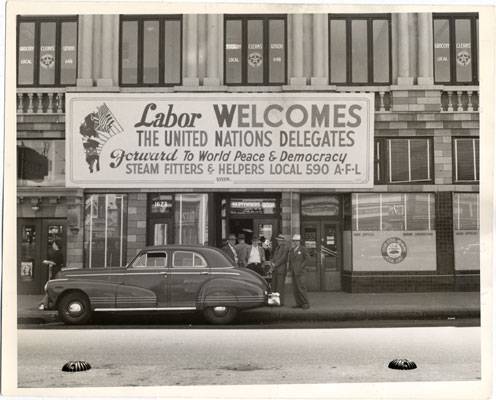Sidney Roger and the Founding of the United Nations in San Francisco
Historical Essay
by Gerry Jamin
While both the Bay Area Council Against Discrimination (BACAD) and the Fellowship Church contributed to an independent, cosmopolitan, left intellectual climate in 1940s San Francisco, perhaps the most authoritative local voice to adopt anti-fascist and anti-imperialist war aims as part of a popular, internationalist mission was that of radio and print journalist Sidney Roger.
Photo: Calisphere, University of California
In both his “Tokyo Inside Out” series of articles in the San Francisco Chronicle and his broadcasts for KGO and KSFO radio, Roger applied a self-taught expertise on foreign affairs and his experience as broadcaster for the Office of War Information (OWI) to his delivery of what might be called a “people’s internationalist” message to the city’s public-at-large. During the war, in addition to his work as a journalist, Roger was the “Voice of America” for the Far East theater, monitoring Japanese media and producing pro-Allied radio broadcasts from studios in San Francisco’s landmark Mark Hopkins Hotel.(1) But his remaining broadcast transcripts, in addition to his articles and a fascinating oral history recorded in 1989-90, demonstrate that Roger was not simply a mouthpiece for U.S. wartime foreign policy.(2) Even while attacking Japanese rhetoric, he maintained an independent critique of imperialism, fascism and racism that challenged U.S. policymakers and the public at large to confront the inconsistencies of an alliance with the imperial powers of Britain, France and Holland. And, like that of his contemporaries discussed above—some of whom he interviewed for local radio—Roger’s critique was not separate from one of the American color line.(3)
The Mark Hopkins Hotel on Nob Hill, mid-1990s.
Born in Paris in 1914 to radical eastern European Jews, Roger immigrated to California as a child and entered the world of broadcasting after being involved in the Federal Theater Project and other Popular Front activities.(4) By the 1930s Roger was a staunch and outspoken antifascist, and he later emphasized that, unlike many of his contemporaries, for him the term “fascist” was not tied to any particular nationality.(5) Even before the U.S. entered the war, Roger was mocking the San Francisco elite who entertained the local Nazi consul (and Hitler’s former commanding officer) Fritz Wiedemann.(6) By the time the U.S. was in the war, OWI Pacific Coast chief Owen Lattimore’s disclosure to Roger that the FBI had designated him “prematurely and excessively anti-fascist” was taken (by both men) as a point of pride.(7) Roger would become an influential figure in the Bay Area left as much for his personality as for his politics. As Jessica Mitford put it, Roger was known for his “ability to get across a thunderously radical left-wing message in a winningly popular style.”(8)
In columns written during the United Nations Conference on International Organization (UNCIO) that took place from April 25 to June 26, 1945, Roger makes a spirited pitch for superceding both the colonial and Jim Crow systems by framing an ideological battle between the Allies and the Japanese government for the hearts and minds of colonial subjects. While the Allies may be aware of “the true nature of Jap Fascism” he wrote, the Japanese were themselves aware of “the general feelings of a billion colonial peoples, and those living on the racial-economic margin of society.” Hinting at the Allies own imperialism, he referred to Japan as “the most predatory imperialist nation.”
As he later commented on the appeal in colonial Asia of the Japanese slogan “Asia for the Asiatics,” “It was very seductive to people who had been kicked around by the white man.”(9) Reporting on the “Greater East Asia Conference” of Japanese puppet regimes, whose declaration, remarkably, spoke of “eliminating monopolistic practices, despotism, imperialism and racial discrimination,” Roger called on the UNCIO “to come through with something better.”(10)
Motivated by his own principles, but also carefully playing upon Americans’ impulse to distinguish themselves morally from the Japanese enemy, he warned that “the poverty of real democracy” in the current Allied plan for colonial areas appeared “quite shabby” as depicted on Japanese radio.
As Roger later recalled, his OWI job of monitoring and countering Japanese propaganda and encouraging anti-Japanese resistance in East Asia put him in an awkward position. Aside from having to discredit Japanese “anti-imperialist” rhetoric while working for an Allied coalition that included imperial powers, he was also faced with Japanese reports of racial confrontations in the United States, such as the 1943 Detroit riots. According to Roger, OWI broadcasters did not attempt to refute these reports, but, thus impelled to offer their own account, just “repeated the straight facts” about what had happened.(11) As Roger later reflected on the contradictions of the wartime colonial issue:
“What was sticky was that—despite our propaganda for freedom and our stated belief in the right of people to enjoy self-determination—we still wondered if we had a claim on the loyalty of the people there? Why ask them to fight like hell against exploitation by Japanese and then tell them to welcome back exploitation by ‘democratic colonialism?’ A true oxymoron.”(12)
Further complicating Roger’s ethical dilemma was the fact that he was forbidden in OWI broadcasts from making any mention of the Japanese emperor or Japanese industrialists as enemies—the preferred term was “Japanese militarists.”(13) But Roger was able to follow his instincts more fully in his endorsement of indigenous anti-Japanese and anti-colonial forces both as the Voice of America in East Asia and in his Bay Area journalism. He was the first American to report on the Philippines revolutionary movement called the Hukbalahap in the pages of the San Francisco Chronicle. He spoke highly of its members, as much for their interest in land reform as for their success against the Japanese and later criticized the U.S.-backed postwar regime for attacking them as communists.(14)
UN Conference 1945, Ethiopian delegation at City Hall, San Francisco.
Photo: San Francisco History Center, SF Public Library
Roger in fact met and interviewed several Filipino guerrilla fighters along with other partisans who had come to San Francisco for the UNCIO. In a June 1945 interview with two of these fighters, Roger stated that “the Philippines is the number one moral factor in all of Asia…[because] the Filipinos are the only people [who] rose up when they knew it was for independence.”(15) His recollection of meeting Filipino guerrilla leader Tomas Confesor at this time demonstrates both the hopes Roger felt at the time and his bitterness toward the increasingly evident regression towards an Allied sponsored neo-colonial order in Asia. Roger recalled that Confesor was then “on the outs” in the Philippines because he “wanted more for the country than just getting rid of the Japanese army,” and so refused to discourage the underground movement in preparation for American re-occupation. Confesor’s tale of the Japanese collaborators—including future president Manuel Roxas—who regained governmental positions under the Allied occupation completes the picture.(16)
Roger was a keen observer of the political activity in San Francisco during the UNCIO, both among the delegates and the “little army” of observers and activists. He recalled a Dutch diplomat getting booed by pro-independence Indonesians, the complexities of the “two-China situation,” and a confrontation between Indian independence leader Vijaya Pandit and British Foreign Secretary Anthony Eden.(17) But perhaps his warmest remembrances are of the numerous anti-Axis guerrilla fighters present in San Francisco during the UNCIO, people who Roger called “the conscience of the conference.” Roger recalled not only the Filipinos, but also French maquisards and members of the resistance from Norway, Greece and Yugoslavia. He found it natural that these men were “pretty far to the left” because, as he saw it, “[m]aybe it took those kinds of people to risk staying behind the lines.”(18)
Crowd outside Opera House after first meeting of UN Conference, April 25, 1945.
Photo: San Francisco History Center, SF Public Library
It is Roger’s seamless blending of anti-colonial and anti-fascist impulses, together with an emphasis on the “racial-economic” inequalities in the U.S. itself, that make his thought so compelling and such a distinct example of the kind of radical internationalist and humanist ideas that were heard during World War Two. He expressed the excitement and hopefulness of these ideas when he remembered the Yugoslav partisans, who affirmed for him “the most exciting aspect about the fight against fascism, which was the people rising up.”(19) As the war in Europe ended but the war in the Pacific still raged, Roger broadcast the message that “The war to the very end in Europe proved to be a ‘People’s War,’ with the little people fighting for their own liberation.”(20)
As the UNCIO wound down, it became clear that Roger’s vision of “a People’s War leading to a people’s peace,” of a United Nations organization that would be “responsive to the needs and desires of the overwhelming masses of people,” and addressed the issues of poverty and inequality—the “real causes of war”— would not become reality.(21) But his broadcasts in the immediate postwar years maintained the same synthesis of world economic and colonial-racial problems, including an analysis of the U.S. movement for ethno-racial democracy in world terms. In a 1946 broadcast, Roger tied the struggle for equal rights in the United States to “a tremendous world-wide upheaval…part of a world trend that is going to change the world.” As Roger put it, “the racial problem at home” reflected the current movements for independence in Indonesia, India, and the Middle East, and “the fierce desire for complete independence in the Philippines.” Addressing his listeners in the language of the Popular Front, he warned, “If we don’t solve these racial problems in the democratic, American way….’with liberty and justice for all’….we will still have hanging over us the knowledge that the Japanese and Nazis won at least one big battle.” Continuing his attempt to hold American leaders accountable to the popular aims of the war, Roger reminded his audience that the message of wartime Japanese propaganda, “heard throughout Asia and down into the Americas…[was] that we do not believe in democracy for all…regardless of race.”(22)
Steamfitters welcome United Nations, 1945.
Photo: San Francisco History Center, SF Public Library
In addition to broadcasting criticism of U.S. policy toward colonial Asia—including an explicit condemnation of U.S. support for Francoists and other collaborators in the Philippines—Roger inveighed against the “great cartel interests” behind U.S. intervention in Greece and defended the American workers who participated in the 1946 strike wave. While Americans found themselves “time after time, too consistently, supporting the very interests abroad which do not represent democracy,” American workers chose strikes as “the last available weapon to fight a deeper condition…low standards of living in the world’s richest nation.”
In contrast to the gloomy trends of U.S. postwar policy, Roger continued to counterpose the democratic and egalitarian vision that had gained such wide popularity during the war. He looked forward—naively, as he later admitted—to a genuinely progressive U.S. foreign policy, one in which the State Department would “look into the facts and lend support to every movement that desires freedom and democracy…rather than supporting special industrial and financial interests and unpopular monarchies and self-styled leaders who represent trifling minorities.”(23) But, while in the 1940s Roger contented himself with speaking about “American ideals,” in spite of increasing signs of official hypocrisy, he later acknowledged that he and other members of the OWI had “assumed a great deal” about the real goals of U.S. postwar plans. Roger recalled his increasing disappointment as the postwar renewal of the colonial order became clearer, and referred to his optimism during the war as “wishful thinking.” “[W]e tried to emphasize the idea that the world could not go back to its old ways because change was in the air, everywhere.”(24)
Roger’s faith in antifascism and deep respect for the aims of the “people’s war,” as noted above, implied certain direct criticisms of U.S. policy which did not go unnoticed by the federal government. Roger’s outspokenness on commercial radio broadcasts about the U.S. relationship with the Franco regime prompted the U.S. state Department to withhold his passport, thus canceling his plans to go to the U.S.-occupied Philippines in 1945, where Roger’s voice was well-known to the underground. Roger later also attributed this decision to comments he had made in his Chronicle column which, contrary to OWI protocol, denounced the Japanese industrialists and described the Tojo regime as “capitalism in its most murderous form.”(25)
Roger’s blending of world anti-fascism, anti-colonialism and working class solidarity would continue in the years that followed, marking a rich but challenging career during the McCarthyist period and beyond.(26) Roger’s philosophy—like that of BACAD, the Fellowship Church, and other California internationalists—is a good example of the kind of left internationalist thinking that found a particularly receptive environment in California in the 1930s and 1940s. This was the intellectual climate of the Bay Area in which world leaders gathered in 1945. And, significantly, it was also the climate in which two significant workplace confrontations occurred, ones that brought into sharp focus the contradictions raised by Roger in his call for ethno-racial democracy : the shipyard civil rights fight and the machinists' dispute with the War Labor Board.
Notes
1. Sidney Roger. 1990. A Liberal Journalist On the Air and On the Waterfront: Labor and Political Issues, 1932-1990. (Interviews by Julie Shearer) University of California. pp. 66, 133, 151-152; The OWI studios were set up with the help of KSFO radio. Its programming was transmitted from antennae on Islais Creek. See Dr. Adrian M. Peterson “A Voice Across the Pacific: KWID & KWIX". (May 14, 2010)
2. Interestingly, Roger notes that even among his colleagues in the OWI there was “a significant group…not a majority but a large group…who were definitely on the left.” Roger, A Liberal Journalist p69
3. Roger describes his interviews with Robert Kenny and Carey McWilliams in Roger, A Liberal Journalist 497-99
4. Roger, A Liberal Journalist pp3, 5-6, 55-56, 160
5. Roger, A Liberal Journalist 71, 195; “By the 1931 Mukden incident, in China, I didn’t need to be told that Japanese imperialism was another form of fascism” Roger, A Liberal Journalist 71; It would be interesting to know what Roger thought of the comparisons of British and French imperialism to fascism, but this does not come up in his oral history
6. Roger, A Liberal Journalist 63-64
7. Roger, A Liberal Journalist 70
8. Roger, A Liberal Journalist introductory materials, no page number
9. Roger, A Liberal Journalist 75
10. “Tokyo Inside Out,” San Francisco Chronicle, April 30, 1945 p9 and May 21, 1945 p5; Although Roger clearly expresses his internationalism and anti-racism in numerous instances, his Chronicle articles do include the contemporary epithet for Japanese people during the war. His usage seems to be confined to descriptions of the Japanese government. I found no evidence in the materials on Roger of any condemnations of Japanese people in racial terms.
11. Roger, A Liberal Journalist 71-72;172
12. Roger, A Liberal Journalist 172-173
13. Roger, A Liberal Journalist 73, 173, 196
14. Roger, A Liberal Journalist 82-83;127, 209
15. “Interview with Filipino guerrillas”. Cassette in Sidney Roger Collection, Labor Archives and Research Center, San Francisco State University. [Hereafter LARC, SFSU] This interview is also recalled in Roger, A Liberal Journalist p78, p141 and p188-189.
16. Roger, A Liberal Journalist 82-83;128-130
17. Roger, A Liberal Journalist 137-138
18. Roger, A Liberal Journalist p85, 126, 133, 487
19. Roger, A Liberal Journalist 153
20. May 10, 1945 broadcast; Radio Scripts 1940s, Sidney Roger Collection, LARC, SFSU
21. May 10, 1945 transcript, ibid
22. March 18, 1946 transcript, ibid
23. October 3, 1946 transcript, ibid; March 18, 1946 radio script, ibid.
24. Roger, A Liberal Journalist 172-173
25. Roger, A Liberal Journalist 79-80
26. Roger was baited as a communist by the Tenney Committee in 1947. He later said that his red-baiting had “mostly to do with my attitude toward racism.” Roger, A Liberal Journalist p71


